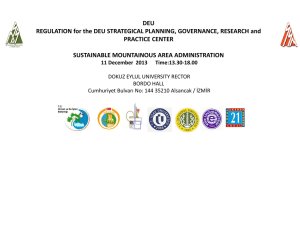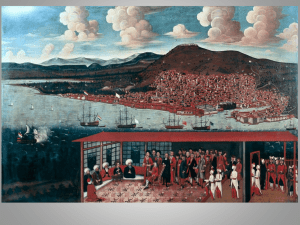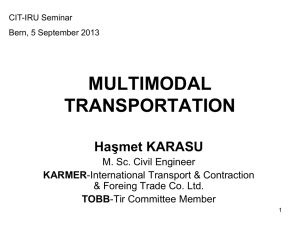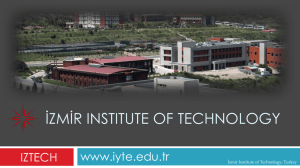kemeraltı_sibeldostol_report
advertisement
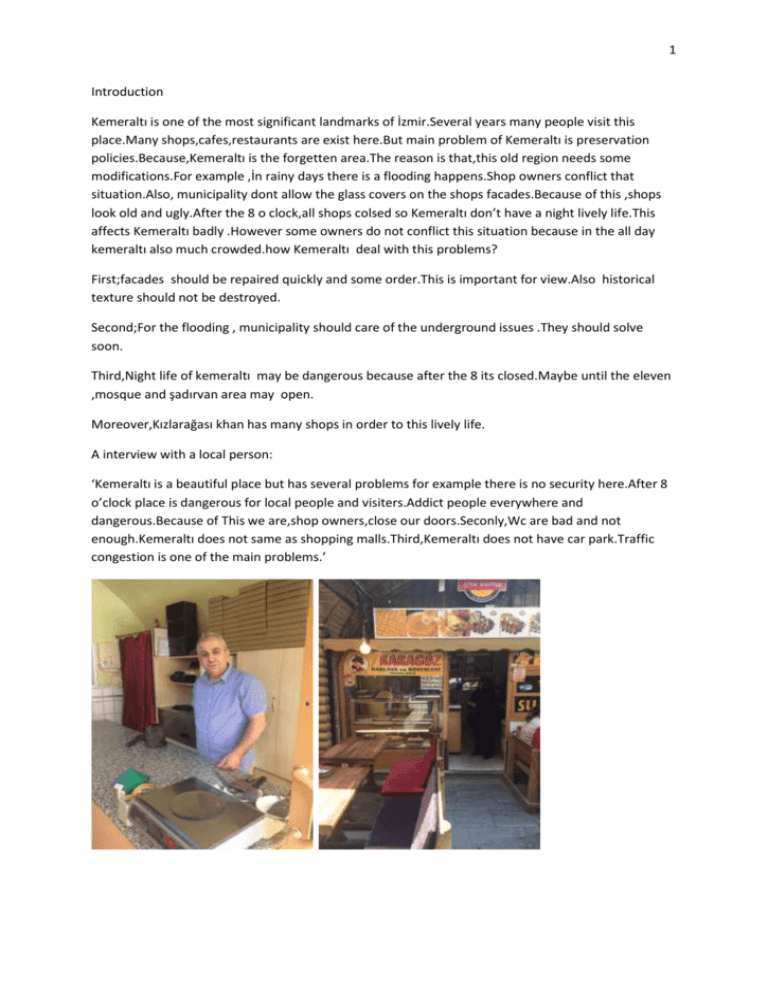
1 Introduction Kemeraltı is one of the most significant landmarks of İzmir.Several years many people visit this place.Many shops,cafes,restaurants are exist here.But main problem of Kemeraltı is preservation policies.Because,Kemeraltı is the forgetten area.The reason is that,this old region needs some modifications.For example ,İn rainy days there is a flooding happens.Shop owners conflict that situation.Also, municipality dont allow the glass covers on the shops facades.Because of this ,shops look old and ugly.After the 8 o clock,all shops colsed so Kemeraltı don’t have a night lively life.This affects Kemeraltı badly .However some owners do not conflict this situation because in the all day kemeraltı also much crowded.how Kemeraltı deal with this problems? First;facades should be repaired quickly and some order.This is important for view.Also historical texture should not be destroyed. Second;For the flooding , municipality should care of the underground issues .They should solve soon. Third,Night life of kemeraltı may be dangerous because after the 8 its closed.Maybe until the eleven ,mosque and şadırvan area may open. Moreover,Kızlarağası khan has many shops in order to this lively life. A interview with a local person: ‘Kemeraltı is a beautiful place but has several problems for example there is no security here.After 8 o’clock place is dangerous for local people and visiters.Addict people everywhere and dangerous.Because of This we are,shop owners,close our doors.Seconly,Wc are bad and not enough.Kemeraltı does not same as shopping malls.Third,Kemeraltı does not have car park.Traffic congestion is one of the main problems.’ 2 Kemeraltı is a historical market (bazaar) district of İzmir, Turkey. It was originally formed around the street surrounding the shallow inner bay of the city, which was filled in due course during the 17th century, availing the bazaar to be extended to a wider area. The street, that traces a wide curve and called today as Anafartalar Street (Caddesi), and known historically as the Street of the Mevlevis, in reference to the presence of a "dergah" (a building designed for gatherings of a Sufi brotherhood) situated by the street, constitutes the principal axis of Kemeraltı. The district covers a vast area extending from the level of the Agora of Smyrna (the quarters of Namazgah, Mezarlıkbaşı and İkiçeşmelik), to the seashore along the Konak Square. It remains one of the liveliest parts of İzmir. The first step that paved the way for the emergence of the present-day Kemeraltı area was the building in 1592 of Hisar Mosque. It is the oldest and one of the most significant Ottoman landmarks in İzmir, although built by Aydınoğlu Yakup Bey, a descendant of the dynasty that had founded the Beylik of the same name (Aydinids) which had controlled İzmir prior to the Ottoman conquest. The name of the mosque, which means "fortress", makes reference to the Genoese castle of "San Pietro", previously called Neon Kastron in Byzantine times, part of which used to stand on the same location and which gradually disappeared in whole with the construction of new buildings on its spot. The final remains of the castle were cleared up during the construction of new port installations between 1867-1876. The market itself came into existence with the filling between 1650-1670 of the shallowest parts of the inner bay. The process of gaining ground from the bay was pursued in 1744 with the construction of Kızlarağası Han, a still-standing impressive caravanserai that emerged as the nucleus of the market, together with two older "hans", the term implying a caravanserai with more markedly urban characteristics, that have not survived to this day. These was the "Great Vezir Han" constructed by the 17th century grand vizier Köprülü Fazıl Ahmed Pasha, and the neighboring "Little Vezir Han" constructed by his successor Merzifonlu Kara Mustafa Pasha. Another historically important and no longer existing han was "Cezayir Han" (literally "Han of Algiers"), from where western Anatolia's excess labor force had been annually dispatched to the Ottoman protectorate of Algiers for centuries. In fact, among the hundred odd "hans" Kemeraltı counted at the beginning of the 20th century, and clearly visible on a 1905 map drawn by French cartographers on behalf of international insurance companies, only a dozen remain, in full or in part, while most were destroyed during the 1922 Great Fire of Smyrna or afterwards. The remaining part of the inner bay was allowed to silt up progressively throughout the 18th century, the shoreline facing Kemeraltı took its present straight form in the beginning of the 19th, although some of the land along the berth remained unused until the end of that century. In 1829, Sarı Kışla, the Yellow Barracks, the principal Ottoman barracks of the city, gigantic for its time, was built immediately on the sea-side, and a private residence (konak), situated slightly diagonally behind the barracks, was extended and converted into the governor's mansion, demarcating Konak Square that holds its name from the mansion, and which in its turn gave the name to the central metropolitan district of İzmir (Konak) and at the level of which Kemeraltı is considered to start. The governor's mansion still stands, although the Yellow Barracks was demolished in 1955 under instructions from the then Prime Minister Adnan Menderes, who 3 wanted to see Konak Square re-shaped, to the ongoing regret of many Izmirians who had come to adopt the oversize building as one of the main landmarks of their city. The CONTRIBUTION OF TOURISM TO HISTORIC CITY CENTER REGENERATION CASE OF KEMERALTI,IZMIR Urban regeneratıon projects,experienced within many American cities since 1950s and European cities since 1980s,reflect themselves mainly in derelict industrial areas,waterfronts and in central business districts.their planning policies and strategies have led to the provision of a new vision for areas under physical and economıc decay.The main objective of such projects has been the prevention of deprivation and constructıon of new and attractive image that creates high quality and vibrant environments.Although such initiatives are often criticized due to their undesired social impacts,physical and economic impacts are fully appreciated. Policies and Strategies for Regenerating Kemeraltı It is believed that the main objective of a tourism-based regeneration policy for the city center of Izmir should be the conservation of the historical heritage and reawakening some of the noticeable characteristics of the past while providing a locally authentic and attractive image.As a part of city’s historical heritage ,the site should be well-planed and managed considering conservation on the one hand and regeneration employing tourism on the other.Following the policies ,a series of strategies should be developed in order to create a better and attractive environment while solving the existing problems and generating income and employment opportunities.These strategies are stated as follows: *Improvement of public Access to the city center, *Functional change, e.g from warehouse to commercial, *re-use of redundant and listed buildings through rehabilitation and maintenance, *Introducing art and culture through activities,performances,etc. *Streetscape improvements,especially on historically important axes, *Encouraging people,especially young couples and singles,to live and work there, *Increase the number of activities and services for domestic and foreign visitors. *Re-create focal points and redesign squares allowing the gathering of people for different purposes, *Provide and strenghten the internal connections within the area as well as its external links with the other parts of the city. However above-mentioned strategies alone are not sufficient for the achievement of a succesful conservation and regeneration Project.There should also be systematic approach underlying the process.The approach adopted is primarily based on the conservation and regeneration experiences of different countries and the realities of Turkey.Actually these involve seven main steps and provide 4 a satisfactory frame for the conservation and regeneration of the historical core.Other objectives of the Project have been formulated as follows: 1)To provide a social agreement towards the ways of conserving and regenerating the site by using public participation effectively. 2)To develop a common vision connected with the site.This level necessitates a detailed analysis of the current problems and potentials of the site in order to provide a satisfactory basis for policies and strategies. 3)To develop alternative schemes in accordance with the historical background of the area,its potentials,and the needs and demands of the local people as well as of visitors. 4)To İnform public about on-going projects in due time.This level necessitates the organization of public hearings in order to provide a basis where conflicting interest are discussed. 5)To achive the NGOs in serving as a resolution mechanism of various kinds of land-use conflicts. 6)To determine the best scheme that fits the area in terms of economic,physical and social objectives. 7)To develop the sight that the public sector should undertake leading role in making investment whichwill in turn provide an attractive climate for the private sector. Conclusion Considering the above-mentioned objectives it is possible to formulate a series of strategies for the first phase Project area: -An appropriate visitor management plan should be introduced regarding the historic environment and existing and potential pedestrian corridors for the local community,visitors and specific interest groups.The visitor Management Plan should include strategies for integrated Access;it should support the Structure Plan and conservation and regeneration policies and strategies, -Due to its historical characteristics,the organic and narrow Street pattern create difficulties especially in the loading/unloading of goods.therefore a well-organised traffic management scheme should be introduced, -Some of the Streets such as that of 871 leading to the ‘Kızlarağası Han’,926 Street and Havra Street (920 Street) within The Sinagogues’ precinct should be improved and its connections especially with the ancient Agora need to be strenghtened, -Small squares facing religious buildings should be improved and their attractivity increase, -Shoe-makers precinct which is deserted at present should be handled with care.As it is the only vacant part of the historic core,its functions should be carefully determined either via redevelopment or functional change by restoring existing buildings, -Parking possibilities should be improved;new parking areas should be created especially within vacant lots as much as possible. 5 -Small-scale accommodation facilities should be provided via functional change to both enable visitors to locate for short periods and to generate additional income for the people residing in the historical core, -Service sector facilities such as cafes,restaurants and bars within some precincts and on major pedestrian routes should be encouraged, -Traditional arts and crafts such as wood and copper products should be encouraged and any initiative towards attracting visitors to these parts should be developed.Besides all,it is believed that public-priate partnership and public participation are the necessary elements of a successfull implementation process. ‘IZMIR AND KEMERALTI’ Izmır,the city that we are debating within the context of this work is the biggest city of Aegean Region nd the 3.biggest city of Turkey with it’s population exceeding 3 million people at the present day.The recent historical and archeological Works let us know that the city has a 800 years of a past.In this context;Izmir is a very important city for Aegean and Anatolia.Archeological informations Show us that there are some remains from the Neolithic Age and the Bronze Age in Bornova and Karşıyaka districts of the city.But it’s known that the first city named Smyrna which is also the radical of the city’s name is the layout in Bayraklı Tepekule Mound dated B.C3000.At Hellenistik Age(B.C. 4.century)the layout in this region is deserted for some reasons and it is moved to the outskirts of a hill named Kadifekale which was named ‘Pagos’ at archaic times.According to the some legends,Alexandre the Great ordered his people to constract the city again at that place cos of a dream he saw at the outskirts of the Pagos when he was doing the wartime to Anatolia.It can be said that from The Hellenistik Age the city’s center is in the same place. At the present day ,there is the Smryna Agora which is known to be the biggest polity agora around Kemeraltı that is the center of the city.There are also city elements like stadeon,theatre etc.In this area Some historical layers are overlapped in this area cos of the Ottoman Period on the archeologic informations of Smyrna and it makes the protecting Work projects difficult and complex. Kemeraltı is in Konak district of Izmir.Kemeraltı region is lined off with Fevzipaşa Boulevard at northeast ,Eşrefpaşa Street at southwest and Halil Rıfat Bashaw Street at southeast.It is surrounded with historical housing fabric till the ridges of Kadifekale.There are so many archaeologic informations ,historical commerce and housing fabric,mosques and synagogues,historical khans and hotels in this area and around the region there are the so many important administrative and cultural centers metropolitan municipality of the city,opera and ballet,province buildings,cinemas and cultural centers. Kemeraltı is a region that the fonctional section of the housing fabric and commercial fabric which is one of the typical characteristics of Ottoman City is clear.Through the vivid commercial life and Kemeraltı with it’s mosques,khans,synagogues,covered bazaars,shops and the Streets that each one has a different character,Izmir has a very rich cultural heritage which is a cosmopolis and coastal town.But Izmir is a city that comes into value as a complement not only with the monumental structures but also through the fabric characteristics and ıt’s value is increasing day by day.Kemeraltı is a commercial center that protected it’s fabric characteristics till the present day but after the proglamation of the republic there has been some corruptions in it’s fabric totality and so it’s 6 historical fancies has been decreased on the basis of the facts that the city quickly changed and growed.It is known that the bazaar has a 2700 hectare arena and by the informations we got from the fiscal administration,there are 11.700 business establishments.Kemeraltı Bazaar forms a big part of the city center and Izmir 1.Protecting District Committee is trying to protect the Kemeraltı Bazaar and it’s neighbourhood by enunciating that the region is an urban archeological protected area. Izmir has been a very affective and important city at each age of the history cos of having a geographical and geopolitical position.Izmir has been growed largely since the year of 1950 by a stream of emigration and became a metropolis with it’s port,developing industry and commerce and the efficient farming basises around.At the same time the Levantine,Jewish and Armenian population that settled down to the city in the time of empire began to leave Izmir and so there has been important changes at social organism of the city.However it can still be seen the reflects of having a multicultural life in the past on city culture at present day.Izmir is faced with the problem of loosing most of the historical values at urbanization process and modern /capitalist accumalation as a metropolis in a developing country.At the ottoman age mostly the turkish population was settled down to the Kemeraltı Bazaar which has been the center of the city for ages and some archeological areas like agora,Kadifekale,theatre,stadeon that are around the city center(the upward part of the ikiçeşmelik Street)but in the continious process the area is left by the old users and new groups has been settle down who emigrated from different cities and became a blighted area.There are people who emigrated from the Southeast Anatolia and also roman citizens in the area at the present day.This area’s people are very poor and so it’s been a selected area by marjinal sectors.This creates so many social problems and makes it difficult the utilization of the city by the cityfolks and the healing Works. In Kemeraltı Bazaar,commercial life has always been very vivid at all the ages of the history but so many structures which have historical value have lost their original facts while they were turned into modern commercial structures.There can still be seen traditional commerce activities but there is an ocular change in the commercial activities like stads.These changes can also be according profile to the owners of the business firms.It must be emphasized that when the shoe manufacturers moved left Kemeraltı on the years of 1990, a part of Kemeraltı has been an undifined since that time.Kemeraltı Bazaar still has a touristic fact and is a traditional nostalgic shopping center but it’s predominantly been a shopping center for the middle income classes an sub income classes of the city.In this process ıt’s been thought of that Kemeraltı Bazaar has lost it’s charm cos of the big shopping centers which has been established in the east,West,South and North of the city that are very charming for the sub and middle income classes. DISCOURSES,PROJECTS AND PRACTICES ON’IZMIR AND KEMERALTI’ It is observed notably recently that the local assets,which are increasing simultaneously with the discourse of globalization in the World practice,have become outstanding.Within this context ,historical city centers are undertaking an increasingly more strategic role in the shaping of the future 7 of cities.An historical center means something for all city-dwellers within the context of being the space ,where the urban culture is shaped and the place,where the consciousness of city-dwelling and belongingness is formed.At this point ,it can be found out that the future scenarios and projects developed on the historical center of the city of Izmir are in fact of strategic importance in terms of the specification of the city’s vision.The fact that what is historical and authentic is getting more and more valuable with postmodern expansions and the economic value it is gaining within the process of a tourism of culture enable the formation of the contributions and participations of all actors in the city in the context of discourse and practice on the historical center.The fact that the historical characteristics of the site is getting lost day by day especially due to the changing commercial structure causes the local administrations,non-governmental organizations and Professional chambers to concentrate their attention on the site.It can be stated that there is actually a twodimensional tendency in this concentration.the first of these tendencies can be conveyed as that the importance of the information and value what is historical carries for the public begins to be perceived since it cannot be replaced after so much wrong applications and the second can be conveyed as that together with an increase in the stress on what is historicali which is developing with the postmodern discourses during the last processes conservation has become a fashion on the tourism-commerce axis with a context of nostalgia and that the economic value it has begun to carry has become outstanding. Studies concerning Kemeraltı are of strategic mainly for the city-wide.As a metropolitan city of a developing country,the city of Izmir has important problems in a number of issues such as the shanty,the supply of housing estate,the disappearance of agricultural basins,industrialization,inadequacy of the port spatially,transportation and social and technical deficiencies of infrastructure.Within all these problematic cases,the vision of the city of fairs and congresses:Izmir which has been put forth concerning the area consisting of 9 metropolitan districts defined as Izmir central city within the law on Metropolitan Municipalities No:5216 and in which nongovernmental organizations in the city are also participating,has been adopted as a savior policy and the historical center is being planned to be an attractive and authentic element presenting the cultural and touristic opportunities to support this vision in the city.It is observed that the studies on the historical center were concentrated for the first time especially during the period of Ahmet Piriştina the mayor of Izmir Metropolitan Municipality.Since 1978 it has been targeted in the topscale plans of the city of Izmir to move administrative and business center of the city to BayraklıTuran Region located behind the Port of Izmir with a view to preventing the multistory rent pressure at the historical city center and to creating a modern center and it has been planned to protect the historical city center by relieving and to enableit survive through cultural and touristic activities.However,this foresight is unable to realize since such a public investment and business volume have not been constituted yet to materialized such a great modern center in the city and the demand for multi-story buildings is concentrated around the city center still as a threat.Therefore,the urban authorities discuss the future of Kemeraltı with its spatial,economic and social dimensions and try to develop suggestions concerning the site Historical Areas and Preservation in the World and in Turkey “the city is and has always been throughout the ages at the root of our culture,history,art and traditions.It has been the birth-placeof a society in constantevolution”.Beyond its historical contribution to the physical environment,urban heritage is the intersection point between a society’s 8 cultural past and its future probabilities.Hence,preserving these structures is important for ensuring cultural continuity.”preservationist often talk about the value of historic properties:social value,architectural value,historical value,the value of sense of place.In fact one of the strongest arguments for preservationought to be that a historic building has multiple layers of value to its comunity. It is possible that starting with preserving the historical area rather than preserving landmarks was first brought to attention throught the preservation of the area which originally created abackground for these structures.The transition from a structure based preservtion to an area based preservation was only realized after the second half of twentieth century.”through the contributions of international organizations including UNESCO,ICOMOS and the Council of Europe,cultural heritage is becoming recognized as a significant link in urban life and the development process. In the period after World War 2,industrialization led a significant role in the rapid migration from ruralto urban areas(similar to other European conturies)and as the urbanization process gradually continued to increase it substantially affected historical cities similar to the manner it affected other regular cities.While cities grew rapidly,historical city centres also experienced transformation processed.On the one hand,these centres were physically deteriorated with the pressure of economic profitsbility caused by the increasing population:and on the other hand ,the centres’social attributes were modified along with the change of the user groups. From a contemporary point of view,the main problems of these plans may be listed as: .main decisions that could damage traditional texture .building new transportation axis and or expansion of existing routes .suggestion of larger or high rise parking lots. .Permitting structures with base area discordant with traditional structures and with multiple buildings. .not being able to provide appropriate protection for monuments and other historical buildings. .triggering the regeneration process with the increase of structures, .usage decisions dissonant with structures and deformation of architectural attributes. Kemeraltı historical City Centre and planning studies with preservation intensions Telling the historical city centre of izmir and its development can only be happened by relating the progress of the city of Izmir. Kemeraltı is mostly related to the improvement of izmir by being an important landmark of commerce. 9 Especially in the late 1800s,having one of the most significant harbours in Mediterranean due to its capacity and ease of entrance, izmir has an important role in ottoman economy while a relationship was being forged with the West around the mid nineteenth century. Kemeraltı region was the city centre around the seventeenth century and found itself a place the developing structure of the city in the nineteenth century. In the seventeenth century,Center of İzmir is a location around the inner harbour to Anafartalar Street which is the main axis of Kemeraltı.ın the eighteenth century there were functional differentiations in the axis of business field. Finally the inner harbour has filled in creating an area where retail and wholesale commerce activities are still exist today. there is a Lonca system in Kemeraltı which was established end of 19th century. Many usage options came in specific locations has located in the area. These grouping were formed in a han or generally inside a single structure,however also it is possible for them to be formed along the Street.Many sources shows that the bazaar was formed storage areas mainly took the effect of commerce.Moreover there are manufactoring and handcraft shops exist in the bazaar. The han structures with a commerce function,formulated a significant part of the historical city center in the nineteenth century.In this period ,this area was the only centre supplying the needs of both Izmir and surrounding settlements. The modernization movement beginning after the late nineteenth century manifested itself with streets widening towards the city center,or streets newly opened,demolished han’s and multistroried Office buildings.Furthermore,with the eventual decrease of the population ratio of Armenians,Greeks and Jews due to various reasons,the multicultural structure of the area eventually weakened. But the improvement of the Izmir,many options in the area for example bus terminals,judicial buildings.depots,manufacturing,accomodation changed places,evacuating the city centre.retail commerce but changed smaller areas .specialization gradually lost and different occupations started to appearing .While the paradox between building and land uses started the destruction process of buildings by demolishing them,most buildings unable to experience this transformation due to problems regarding property ownership and similar causes were left vacant. In spite of all these developments, the area continued its existence as the city centre.Yet,with the appearence of shopping areas around the city ,historical bazaar began attracting population groups with average and low income.The decline of functıonal variety in the area caused a reduction in the user group.Hence,the area economically deteriorated. DİSADVANTAGE 1)Competition with large shopping malls.One of the most significant risks threatening the tarditional commercial city centre of kemeraltı is the emergence of large shopping malls and chain stores and their attracting the middle and elite classes.Not only is transportation to these mallls fairly easy but there are also a variety of entertainment and relaxation oriented activities in addition to shopping opportunities all gathered under a single roof;thus they have become a notable opponent of tarditional city centres. 10 2)Usages evacuating the city centre leaving areas decayed. Certain functions (hospital, court, central bus station. etc)that supported the area in the past have been displaced and various production and commerce groups in the area moved to organized shopping districts in the suburbs. This caused the desertion of various commerce areas and offices in the area. The decayed areas are gradually being physically worn down due to the lack of maintenance and this negatively affects surrounding areas and commercial intensity. 3)Functional standardization. Another negative development for the area is that the structure of the area is becoming more standardized whereas it used to encompass a variety of functionsVarietytraditional commerce and production are becoming extinct and the commerce is becoming predominantly small scaled textile trade based, which makes this area less attractive charming. Without a doubt ,the continuity of the area by preserving the physical and social structure depends on strengthening and carrying out the advantages described earlier while eliminating the disadvantages with projects that would convert them to advantages.Planning studies ,public investments,and public awareness should be directed to this area and all the efforts concerning this area should be encouraged. For example,the budget allocated for preservation ia an opportunity.:however,this is a limited resource when the entirety of cultural assets in turkey is considered.Therefore ,spending this resource by setting the priorities right is vital.Similarly,movements towards participation and establishment of civil public organizations are positive developments.However ,the increase in social awareness needs to take larger steps to carry on this tendency with strength. While the decaying areas seem like a problem ,they can potentially be used in the future.These areas can be regarded as an opportunity for recreation.for example ,the structure complex decayed by the judicial court and siuated between Konak Square and Kemeraltı Bazaar was considered a modern architectural examplein the period it was built;however,it now stands as a Wall between the bazaar and the square and prevents perceptionof the bazaar.This large deserted area may be used for redesigning and transforming the area. Similarly, opportunities can be provided to create advantages in the existing competition betweenKemeraltı and the developing shopping malls.For instance,the Access of mass transit systems may be increased.By increasing the number of socio-cultural facilities ,there may be opportunities for multiple purpose usages of the area.Depending on the demands,standardized commercial usage can be diversified with the support of cultural tourism that will create demands toward traditional production commerce. In addition to the increasing interest in preservation studies in TURKEY,particularly Izmir,participation efforts that startedwith the planning process and continued with the applications have had positive results and it was evident that this was instructive at least on the social awareness of preservation -The continuity and integrity of planning and implementation processes. -Participation an continuity of the planning and implementation processes. 11 -The significance of the education in preserving cultural heritage. CONCLUSION Problems related to the Kemeraltı Preservation Plan applications and the success achieved afterwards indicated the significance of both the property owners in the area and thecitizens participation and the interest and efforts in maintaining the sustainability of the plan’s principles.This can be fulfilled only with social awareness.Therefore,training is vital. Secondly,one of the important problems observed during the planning and implementation stages was that there was correlation between the agancies with responsibilities in different areas and subjects other than the preservation of the Kemeraltı region.Legal regulations that clearly and systematically define the rolse and responsibilities is also important. 12 References: Katılımcı Bir Kentsel Koruma Projesi:Izmir Kemeraltı Tarihi Kent Merkezi,Sibel Ecemis Kılınc Preservation Plan Applications for the Historical City Center,Kemeraltı(Izmır,Turkey),Sibel Ecemis Kılınc The contribution of Tourism to Historic City Center Regeneration Case of Kemeraltı,Izmir-Turkey, Özlem Ünal,Ahu Dalgakıran http://en.wikipedia.org/wiki/Kemeralt%C4%B1





